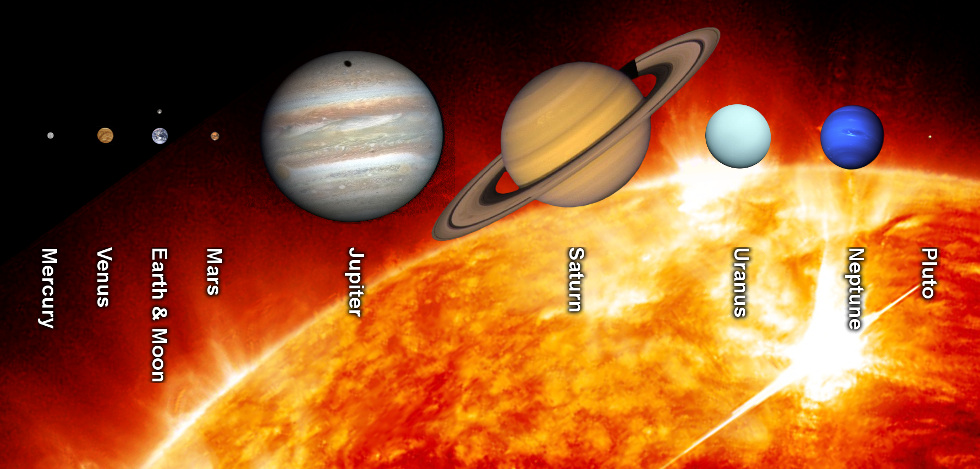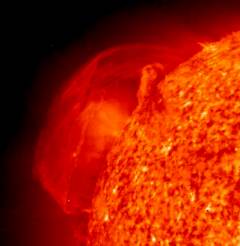The Sun is a pretty mundane star,
like many, many others in the sky, although it is quite large —
it's in the top 10% of stars by mass. However, it has one very
special feature as far as we are
concerned; and that is its closeness to Earth, some 276,000 times
closer than the next-nearest star. Because of this, it appears large
in the sky, compared to other stars; and its heat and light keep the
Earth from freezing, and in fact, fuel all life on earth.
Solar Statistics
The Sun is huge: 1,390,000 km. across, compared to the Earth,
which is a tiny 12,756 km. across, and is more than 320,000 times
heavier than the Earth. In fact, the Sun contains more than 99.8% of
the total mass of the solar system!
To get an idea of the
incredible scale of the solar system, look at
this diagram of the sizes of the planets (and Pluto), with a corner of
the Sun in the background — at the same scale. Notice how the Earth could
comfortably fit under one jet of gas from the Sun — many times over!
The Sun has a very dense core in which its energy is generated, at
a temperature of 15 million degrees Celcius. The Sun is mostly (about
70%) made of hydrogen, but at the core, this is slowly being converted
into helium by nuclear fusion; "slowly" meaning that 700
million tons of hydrogen are converted into 695 million tons of
helium every second. The "lost" 5 million tons per second of
mass is converted to pure energy, in the form of incredibly intense
gamma rays. Fortunately for us, as this energy makes its way out
through the layers of the Sun — taking thousands of years —
it is continuously absorbed and re-emitted in less energetic forms,
until it emerges mainly as heat and light.
The Outer Layers
Surrounding the bulk of the Sun's mass is a layer called the
photosphere, which is only about 500 kilometres thick, but
which is totally opaque; this is what we see as the "surface" of the
Sun. The photosphere is relatively cool, at only 5,500 degrees
Celcius. Cold dark spots (sunspots) can
sometimes be seen in the photosphere; these are actually only cold in
relative terms, at about 3,500 degrees. Sunspots can be as much as
50,000 km. across; but nobody really knows what causes them, or how
they work.
Surrounding the photosphere is the chromosphere, a layer of
gas about 4,000 kilometres thick, glowing with a distinctive red
colour (although it's almost completely transparent, and so normally
invisible).
Beyond the Chromosphere is the corona, a huge "atmosphere"
of very thin but extremely hot gas, at about 2 million degrees
Celcius, extending millions of kilometres into space. Nobody quite
knows why it's so hot, when the Sun's surface is much cooler.
Solar Fireworks
Extending into the hot corona are solar prominences,
relatively cool (10,000 degrees or so) loops and tongues of gas
suspended in the far hotter corona. Prominences can be as far as
50,000 km above the photosphere, and can be as much as 10,000 km thick
and 600,000 km long. (You could fit Uranus, the third-largest planet,
under one of those prominences!) Solar prominences can occur in
active regions of the Sun (ie. where there is significant sunspot
activity), or in quiet regions.
Prominences can last several months, and hang suspended, sometimes
moving up or down, in the corona; then, at the end of their
lives, they typically shoot upwards at several hundred km/s, and
dissipate. Since prominences are denser, and hence heavier, than the
surrounding coronal gas, there must be something holding them up;
although the explanation for this is not fully understood, it is
almost certainly to do with the complex magnetic fields of the Sun.
One of the most spectacular features of the Sun is the
solar
flares. These are basically huge explosions of energy —
equivalent to millions of 100-megaton hydrogen bombs exploding at the
same time — bursting out from the Sun's atmosphere. These flares of
energy can extend far out from the Sun's surface, well into the
corona, and can be very hot; as much as 100 million degrees. Unlike
solar prominences, flares always occur in active regions of the Sun,
and are extremely rapid events; a typical flare is over in a few
minutes, although the larger flares can last for an hour.
Seeing Is Believing
As you can see in the picture here, these phenomena are
extraordinary and beautiful events. So, how can one observe the
chromosphere, corona, and (when the Sun is particularly active)
prominences, and solar flares? The immediate problem is that they are
too dim to be seen next to the Sun's disk, since the light from the
photosphere would totally flood them out — the corona, for example,
is a million times fainter than the photosphere.
So, if we block out the photosphere, the Sun's fainter features
should become visible — in theory. This works in space, but on Earth
it's no good — the remaining light from the sky (Sunlight scattered
by the atmosphere) means that only blue sky would be visible. So us
earthbound mortals can never see the beauty of the Sun's structure —
unless we can arrange for the Sun's photosphere to be blocked by
something outside the atmosphere. Wouldn't that be cool!
So can the Moon do it?
Just the Right Size
Well, really, we are asking a lot. In order for the chromosphere,
corona and solar prominences to become visible, we need the
photosphere to be totally blocked out; that means that the Moon needs
to be big and/or near enough to cover it completely. But, if the Moon
is too big and near, it will also cover up the features we want to
see! So we need it to be just the right size and distance from the
Earth.
And we're in luck! By an amazing — and very fortunate —
coincidence, the Moon is just exactly the right size and distance from
the Earth to do the job. In fact, if it was just a little smaller or
farther away, we would never see a total eclipse.
Actually, as explained in
Mechanics of Solar Eclipses,
because the Moon's orbit is slightly elliptical, the degree to which the
Sun is covered during an eclipse varies slightly. In fact, on average,
the Moon is 0.531° in angular diameter, which is
smaller than the Sun's average of 0.533°; though the Moon at perigee
can be up to 0.568°, which easily covers the Sun. This is why more central
solar eclipses are annular than total. The
statistics page has more information
on the sizes of the Sun and Moon; and the
Moon Data page displays detailed
information on the Moon's key dates.
All of this means that during a total solar eclipse, and
only then, the Sun's corona can be seen from Earth; and this is
what makes an eclipse such a rare and wonderful event. It is made
even more rare by the fact that a total eclipse can only be seen from
a tiny part of the Earth's surface; so you have to make sure that
you're in the right place at the right time!
Last Word...
By the way, the Sun is about 5 billion years old. It
has used up about half of its hydrogen fuel, and should keep going for about
another 5 billion years or so. After that, watch out!


